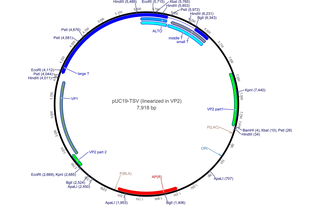pUC19-TSV (linearized in VP2)
(Plasmid
#70032)
-
PurposepUC19-TSV (linearized in VP2) contains a genome of the Trichodysplasia spinulosa-associated polyomaviruse (GenBank NC_014361) linearized and cloned in the VP2-coding region
-
Depositing Lab
-
Sequence Information
Ordering
| Item | Catalog # | Description | Quantity | Price (USD) | |
|---|---|---|---|---|---|
| Plasmid | 70032 | Standard format: Plasmid sent in bacteria as agar stab | 1 | $85 | |
Backbone
-
Vector backbonepUC19
- Backbone size w/o insert (bp) 2686
- Total vector size (bp) 7918
-
Vector typeBacterial Expression ; Cloning vector
Growth in Bacteria
-
Bacterial Resistance(s)Ampicillin, 100 μg/mL
-
Growth Temperature37°C
-
Growth Strain(s)NEB Stable
-
Copy numberHigh Copy
Gene/Insert
-
Gene/Insert nameTSV full genome, linearized in VP2 gene
-
Alt nameTrichodysplasia spinulosa-associated polyomavirus
-
Alt nameCommon abbreviations: TSV; TSPyV
-
SpeciesTrichodysplasia Spinulosa-associated Polyomavirus
-
Insert Size (bp)5232
-
GenBank IDNC_014361
Cloning Information
- Cloning method Restriction Enzyme
- 5′ cloning site EcoRV (destroyed during cloning)
- 3′ cloning site SmaI (destroyed during cloning)
- 5′ sequencing primer -
- 3′ sequencing primer - (Common Sequencing Primers)
Terms and Licenses
-
Academic/Nonprofit Terms
-
Industry Terms
- Not Available to Industry
Trademarks:
- Zeocin® is an InvivoGen trademark.
These plasmids were created by your colleagues. Please acknowledge the Principal Investigator, cite the article in which the plasmids were described, and include Addgene in the Materials and Methods of your future publications.
-
For your Materials & Methods section:
pUC19-TSV (linearized in VP2) was a gift from Mariet Feltkamp (Addgene plasmid # 70032 ; http://n2t.net/addgene:70032 ; RRID:Addgene_70032) -
For your References section:
Discovery of a new human polyomavirus associated with trichodysplasia spinulosa in an immunocompromized patient. van der Meijden E, Janssens RW, Lauber C, Bouwes Bavinck JN, Gorbalenya AE, Feltkamp MC. PLoS Pathog. 2010 Jul 29;6(7):e1001024. doi: 10.1371/journal.ppat.1001024. 10.1371/journal.ppat.1001024 PubMed 20686659





